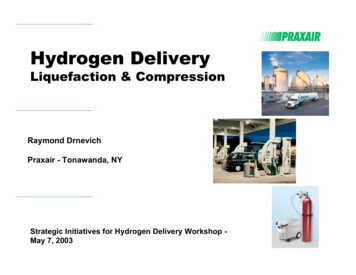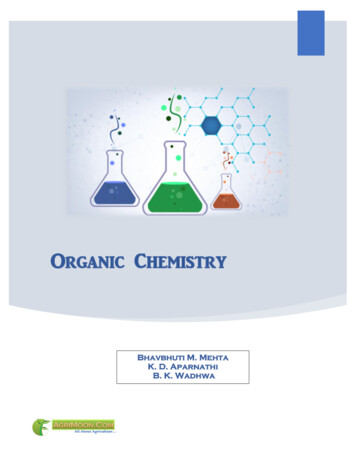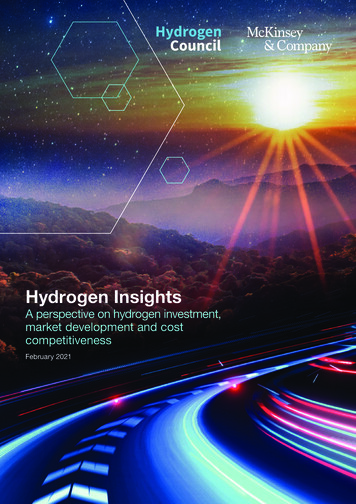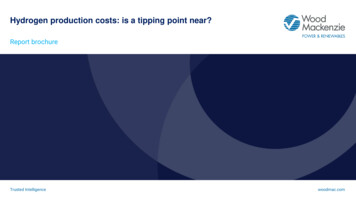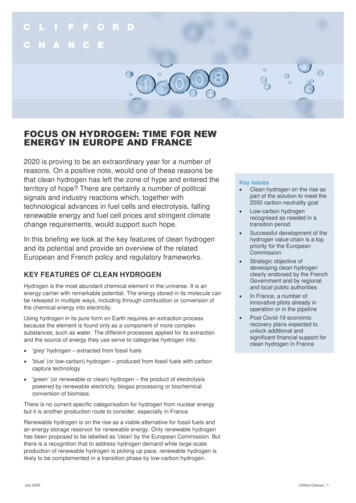
Transcription
FOCUS ON HYDROGEN: TIME FOR NEWENERGY IN EUROPE AND FRANCE2020 is proving to be an extraordinary year for a number ofreasons. On a positive note, would one of these reasons bethat clean hydrogen has left the zone of hype and entered theterritory of hope? There are certainly a number of politicalsignals and industry reactions which, together withtechnological advances in fuel cells and electrolysis, fallingrenewable energy and fuel cell prices and stringent climatechange requirements, would support such hope.In this briefing we look at the key features of clean hydrogenand its potential and provide an overview of the relatedEuropean and French policy and regulatory frameworks.Key issues Clean hydrogen on the rise aspart of the solution to meet the2050 carbon neutrality goal Low-carbon hydrogenrecognised as needed in atransition period Successful development of thehydrogen value chain is a toppriority for the EuropeanCommission Strategic objective ofdeveloping clean hydrogenclearly endorsed by the FrenchGovernment and by regionaland local public authorities In France, a number ofinnovative pilots already inoperation or in the pipeline Post Covid-19 economicrecovery plans expected tounlock additional andsignificant financial support forclean hydrogen in FranceKEY FEATURES OF CLEAN HYDROGENHydrogen is the most abundant chemical element in the universe. It is anenergy carrier with remarkable potential. The energy stored in its molecule canbe released in multiple ways, including through combustion or conversion ofthe chemical energy into electricity.Using hydrogen in its pure form on Earth requires an extraction processbecause the element is found only as a component of more complexsubstances, such as water. The different processes applied for its extractionand the source of energy they use serve to categorise hydrogen into: 'grey' hydrogen – extracted from fossil fuels 'blue' (or low-carbon) hydrogen – produced from fossil fuels with carboncapture technology 'green' (or renewable or clean) hydrogen – the product of electrolysispowered by renewable electricity, biogas processing or biochemicalconversion of biomass.There is no current specific categorisation for hydrogen from nuclear energybut it is another production route to consider, especially in France.Renewable hydrogen is on the rise as a viable alternative for fossil fuels andan energy storage reservoir for renewable energy. Only renewable hydrogenhas been proposed to be labelled as 'clean' by the European Commission. Butthere is a recognition that to address hydrogen demand while large-scaleproduction of renewable hydrogen is picking up pace, renewable hydrogen islikely to be complemented in a transition phase by low-carbon hydrogen.July 2020Clifford Chance 1
FOCUS ON HYDROGEN: TIME FOR NEWENERGY IN EUROPE AND FRANCETHE POTENTIAL OF CLEAN HYDROGENOwing to its characteristics, hydrogen can be used in numerous sectors,including transportation (as fuel for electric vehicles or the maritime andaviation industries), heating (blended with or replacing natural gas heating –power-to-gas projects), electricity (hydrogen produced from renewablesources is stored and then transformed back into power for future use –power-to-power projects), and various industrial processes (e.g. in theproduction of fertilisers or in the steel industry).A central benefit of clean hydrogen is the reduction in CO2 emissions achievedin its production and use. With its many potential applications, especially inenergy-intensive industries, clean hydrogen could play a pivotal role indelivering European decarbonisation targets and achieving the EuropeanCommission's wider commitment to tackling climate and environmental-relatedchallenges, including the European Green Deal which aims for zero netemissions of greenhouse gases in 2050. Clean hydrogen could likewise beinstrumental to delivering France's decarbonisation targets and offer tangiblegreen growth potential for France's industry, a view also shared (for some timenow) by the French Association for Hydrogen and Fuel Cells (AFHYPAC).AN AMBITIOUS EU ROADMAPRecognising the potential of clean hydrogen, the European Union increasinglyperceives it as a key priority to achieve the European Green Deal andEurope's clean energy transition.The EU had already started to include references to clean hydrogen in recentlegislative instruments. For instance, in the context of the EU Clean EnergyPackage, the Renewable Energy Directive expanded the scope of theGuarantees of Origin system to renewable gas, including hydrogen, and theAlternative Fuel Infrastructure Directive set out minimum requirements onalternative fuels infrastructure, including in respect of hydrogen fuelling points.The European Commission's communication published on 8 July 20201 nowdemonstrates a holistic full lifecycle approach for developing a hydrogenecosystem in the EU, the key aspects of which are outlined below.Further details can be found in our briefing The European Commission'sHydrogen Strategy for a Climate-Neutral Europe.The EC strategic roadmap for hydrogenThe European Commission's roadmap is structured in three phases: Phase 1 (2020 to 2024): the strategic objective is to decarbonise existinghydrogen production (e.g. in the chemical sector) and facilitate take-up ofhydrogen consumption in new end-use applications by promoting theproduction of 1 million tonnes of clean hydrogen with at least 6 GW ofclean hydrogen electrolysers installed. Phase 2 (2025 to 2030): integration of clean hydrogen into the energysystem by expansion of the use of renewable hydrogen in new sectors (inparticular steel and transport), producing 10 million tonnes of cleanhydrogen with at least 40 GW of clean hydrogen electrolysers installed.1Communication from the EC to the European Parliament, the Council, the European Economic and Social Committee and the Committee of theRegions, "A hydrogen strategy for a climate-neutral Europe", 8 July 2020, COM(2020) 301 final2 Clifford ChanceJuly 2020
FOCUS ON HYDROGEN: TIME FOR NEWENERGY IN EUROPE AND FRANCE Phase 3 (2030 to 2050): clean hydrogen technologies at large scaleshould achieve maturity to reach all hard-to-decarbonise sectors.While focusing on clean hydrogen, the roadmap also recognises the role oflow-carbon hydrogen production in a transition phase.Investment agenda for the EUThe European Commission has identified actions along the entire hydrogenvalue chain which will require huge investments. For instance, from now to2030, between 24 billion and 42 billion will be needed for the developmentand construction of electrolysers and between 220 to 340 billion to scale upsolar and wind energy production capacity to 80 GW-120 GW to provide thenecessary electricity.To support these investments and the emergence of a whole hydrogen ecosystem, the Commission launched the European Clean Hydrogen Alliance,which brings together industry, national and local public authorities, civilsociety and other stakeholders all along the hydrogen value chain. The keydeliverable of the Alliance will be to rapidly identify and build up a clearpipeline of viable investment projects.A number of EU financial instruments will be made available for thedevelopment of hydrogen. This includes notably the InvestEU programme andthe ETS Innovation Fund. Hydrogen projects could also benefit from the statusof Important Projects of Common European Interest (IPCEI).Scaling up productionUpstream, the key aim is for hydrogen to become cost-competitive with fossilfuels by creating a supportive policy framework. In this vein, the EuropeanCommission is making several proposals, including: Creation of tendering systems for Carbon Contracts for Difference (CCfD),being long-term contracts with a public counterpart remunerating theinvestor by paying the difference between the CO2 strike price and theactual CO2 price in the Emission Trading System (ETS). Direct and transparent market-based support schemes, allocated throughcompetitive tenders. Revision of the State aid framework, including the state aid guidelines forenergy and environmental protection, foreseen in 2021.Backbone transmission infrastructureLarge-scale hydrogen consumption will require corresponding transportationcapacities on a regional, national and trans-European level. In combinationwith newly-built dedicated infrastructure, existing gas infrastructure could berepurposed for hydrogen transmission.However, there are still barriers to overcome: Existing natural gas pipelines are owned by network operators that areoften not allowed to own, operate and finance hydrogen pipelines. Againstthis background, the Commission intends to revise the relevant gaslegislation. Third-party access rules, clear rules on connecting electrolysers to the gridand neutrality of network operators will be needed to ensure nondiscriminatory access to hydrogen infrastructure.July 2020Clifford Chance 3
FOCUS ON HYDROGEN: TIME FOR NEWENERGY IN EUROPE AND FRANCE Another item on the Commission's agenda is to ensure the full integrationand interoperability of hydrogen infrastructure in EU infrastructure planningby including hydrogen in the Trans-European Networks for Energy and theTen-Year Network Development Plans.Interestingly, a group of eleven European gas TSOs from nine EU memberStates, including the French TSOs GRTgaz and Teréga, spontaneouslypresented on 17 July 2020 a plan for a European hydrogen transportinfrastructure, which envisages almost 23,000 km of hydrogen pipelines by2040, approximately 75% of which would be repurposed natural gasinfrastructure2.Boosting demand in end-use sectorsThe European Commission recognises that demand-side support policies willalso be needed to overcome the current higher costs of the use of hydrogen.To such end the Commission: will propose measures to facilitate the use of hydrogen and its derivativesin the transport sector in the upcoming Sustainable and Smart MobilityStrategy, announced in the European Green Deal and due to be presentedbefore the end of 2020; and consider various options for incentives at EU level, including the possibilityof minimum quotas of clean hydrogen or its derivatives in specific end-usesectors (e.g. the chemical sector or transport applications).THE FRENCH HYDROGEN FRAMEWORKThe French hydrogen national strategy – the beginningHydrogen Plan 2018Support by the French Government for clean hydrogen was first announcedthrough a Hydrogen Plan in 2018. This plan was organised around three axes: industry – promoting the share of clean hydrogen in the hydrogenconsumed by industry energy – developing hydrogen as a storage solution for the electricityproduced by renewables mobility – developing clean transport, notably through the construction ofhydrogen fuelling stations.The initial plan could be read as envisaging low-carbon hydrogen as part ofthe "clean" hydrogen being promoted. The role of low-carbon hydrogen in thenational strategy and its share of the public financial support now remains tobe confirmed by the French Government.Multi-Annual Energy Plan (PPE) 20203The development of clean hydrogen and its uses in the industrial, energy andmobility sectors is included in the national Multi-Annual Energy Plan(Programmation Pluriannuelle de l'Energie or PPE) adopted in April 2020. Itspurpose is to map out the energy actions of the Government in the next10 years with the aim of France becoming carbon neutral by 2050.2"European Hydrogen Backbone, How a dedicated hydrogen infrastructure can be created", July 20203Decree No 2020-456 of 21 April 2020 relating to the Multi-Annual Energy Plan4 Clifford ChanceJuly 2020
FOCUS ON HYDROGEN: TIME FOR NEWENERGY IN EUROPE AND FRANCEThe Multi-Annual Energy Plan sets out a number of targets for thedevelopment of hydrogen, as reflected in the table below.By 2023Demonstrators of "power-to-gas" technology (MW)By 20281 to 1010 to 100Share of clean hydrogen in industrial hydrogen10%20% to 40%Number of hydrogen fuelling stations100400 to 1,000Climate Energy Law 2019The Climate Energy Law of 8 November 2019 sets out a target for hydrogendevelopment, by providing that renewable and low-carbon hydrogen shouldamount to 20% to 40% of hydrogen consumption by 2030.French Energy Agency (ADEME)Public financing at the national level has so far been made available mainly bythe French Energy Agency (ADEME) through calls for tenders. In 2019, 90million was awarded for hydrogen transport projects such as hydrogen fuellingstations. In 2020, new calls for tender are being launched by ADEME,regarding for example, the development of hydrogen in the railway sector.The financial envelope initially contemplated in 2018 was 100 million per yearover 5 years, which fell short of the billions of Euros requested by hydrogenstakeholders and, so far, remains far from the 9 billion investmentcontemplated by the German National Hydrogen Strategy announced inJune 2020 for propelling Germany into a leading role in the hydrogeneconomy worldwide.Current momentum for hydrogen development in FranceThe level of public financial support for hydrogen in France is expected tosignificantly increase given recent developments.Covid-19 stimulus plansThe development of hydrogen features as part of the stimulus plans beingpursued by the Government for industrial recovery after the Covid-19 crisis.The support plan for aviation4, for a total amount of public aid (subsidies,loans, guarantees) of more than 15 billion, includes 1.5 billion over the nextthree years towards designing the "clean planes of tomorrow" through the useof carbon neutral fuel such as hydrogen. The plan aims at developing acommercial hydrogen-fuelled plane to replace the A320 by 2033 or 2035 (witha first demonstrator to be ready as soon as 2026).Hydrogen is also part of the support plan for the car industry5 for a totalamount of public aid of more than 8 billion. The Government will for instanceimpose on public entities an obligation to renew their fleet of vehicles with atleast 50% clean vehicles such as hydrogen fuelled vehicles. In addition, theplan includes 150 million to support R&D, notably in hydrogen-fuelledvehicles.4Support plan for aviation published on 9 June 2020 on the site of the French Economy and Finance Ministry5Support plan for the car industry published on 26 May 2020 on the site of the French Economy and Finance MinistryJuly 2020Clifford Chance 5
FOCUS ON HYDROGEN: TIME FOR NEWENERGY IN EUROPE AND FRANCEPolitical supportFurthermore, recent and repeated political declarations make it clear that theFrench State is aware of the need to move shift into a higher gear with cleanhydrogen.The Economy and Finance Minister, Bruno Le Maire, announced on 30 June2020 that the French industrial recovery plan, which is expected to bepresented in autumn this year, would include the development of hydrogenand also reportedly referred in this respect to a possible partnership withGermany. Most recently, in his official speech on Bastille Day, the President ofthe Republic, Emmanuel Macron, indicated the support of the FrenchGovernment for the development of hydrogen to boost the energy transitionand create sustainable jobs. And this approach was echoed by the newlyappointed Prime Minister, Jean Castex, in his speech before the Senate on 16July 2020. Even more recently, on 23 July, a hundred members of the nationaland EU parliaments made a public call on the French Government to set up anew national hydrogen plan covering all the value chain and supported by afinancial envelope comparable to that of other countries such as Germany.These declarations signal the political intention to invest massively in thedevelopment of hydrogen in France.The awaited French hydrogen regulatory frameworkSimilar to the situation at the EU level, there is little hydrogen-specificlegislation in France. There are technical requirements for hydrogen fuellingstations (implementing the Alternative Fuel Infrastructure Directive), but theseare an exception as there are generally few legislative or regulatory provisionsfocusing specifically on hydrogen.That said, significant progress is expected in the coming months since theClimate Energy Law has empowered the Government to issue decrees(ordonnances) setting out the legal framework necessary for the developmentof hydrogen, i.e. to allow the production, transport, storage and traceability ofhydrogen (guarantees of origin) and to create financial support schemes forclean hydrogen. The law had given one year to the Government to do so, i.e.until November 2020, although a delay of several months is expected onaccount of Covid-19. The development of the French regulatory framework willneed to be consistent with the new EU guidelines and legislation.The French hydrogen sector – hopes and pilotsMeanwhile, French industry is starting to focus on hydrogen. Certain leadingFrench companies have developed uses for hydrogen domestically andabroad. A few have already received significant public attention, including: Toulouse-Blagnac – a project undertaken by Engie Solutions and theOccitania Region, as stakeholders of the project company, HyPort, withsupport from ADEME and the EU. It will become the first airport in theworld to host a hydrogen production and distribution station. Jupiter 1000 – a power-to-gas project in the harbour of Marseille/Fos-surMer led by GRTgaz, in partnership with, among others, RTE, Teréga, laCompagnie Nationale du Rhône and McPhy Energy, with support fromADEME and the EU, as well as the Provence-Alpes-Côte-d'Azur Region.Put into operation in February 2020, it aims at using the CO2 produced bythe harbour area facilities and combining it with hydrogen to producesynthesis methane, then injecting it in the gas distribution network.6 Clifford ChanceJuly 2020
FOCUS ON HYDROGEN: TIME FOR NEWENERGY IN EUROPE AND FRANCE Zero-Emission Valley (ZEV) project – an example of regional authoritiesin France actively promoting clean hydrogen. The Auvergne and RhôneAlpes Region launched the ZEV project in 2017 for the deployment of20 hydrogen fuelling stations and 1,000 hydrogen fuelled vehicles in theRegion, with support from ADEME and the EU.These initiatives are but a few of the projects seen over the past several yearsin the sector in France. And activity is certainly accelerating.The French hydrogen industry, represented by the French Association forHydrogen and Fuel Cells (AFHYPAC), is now looking forward to a structuredstrategy from the State. AFHYPAC, whose members include leading Frenchenergy companies (e.g. Air Liquide, Engie, EDF subsidiary Hynamics andTotal), as well as leading French industrial companies (such as Faurecia andMichelin), published on 23 July 2020 a manifesto6 calling for more than 10 billion of public investments over the period 2020-2030 – while around 24 billion of private investments are expected over the same period. Theyalso called for a dedicated governance bringing together public authorities andprivate stakeholders to be put in place in order to enhance France's strategicposition in the hydrogen economy.CONCLUSIONRenewable and low-carbon hydrogen is a source of hope for both meeting thecarbon emission reductions targets and fostering industrial recovery after theCovid-19 crisis. Europe is aiming to be highly competitive in developing cleanhydrogen applications and is positioning itself for a leading role in this market.One of the barriers faced today by developers and investors is the absence ofa comprehensive legal framework for clean hydrogen at the European andnational levels. This legal vacuum must be addressed to ensure thebankability of large projects, enabling investors to commit their equity andhave access to debt finance, which will be key to scaling up the production ofclean hydrogen. Clean hydrogen value chain actors are looking forwardanxiously to the EU legislation to be enacted following discussion of theCommission's strategic roadmap with the Member States, as well as to theregulatory framework that the French Government is committed to issue in thecoming months.As was the case in the beginning for wind and solar power generation, theclean hydrogen industry needs support and time to become cost-effective andcompetitive, both with fossil-based hydrogen and other energy sources.Support by public authorities, including financial support schemes andforward-looking legislation, are therefore needed to transform hope forhydrogen into reality.ABOUTFocus on Hydrogen is a Clifford Chance briefing series covering hydrogen-related developments globally. 1.008 is thestandard atomic mass of hydrogen.For other hydrogen publications, please see our climate, sustainability, green finance and renewables page here.For hydrogen queries in other jurisdictions, please contact Anthony Giustini and Andreas Formosa (listed under Globalcontacts below).6AFHYPAC, "Pour un plan national hydrogène ambitieux et cohérent", 21 July 2020July 2020Clifford Chance 7
FOCUS ON HYDROGEN: TIME FOR NEWENERGY IN EUROPE AND FRANCECONTACTSThis publication does not necessarily deal withevery important topic or cover every aspect ofthe topics with which it deals. It is notdesigned to provide legal or other advice.FRANCEwww.cliffordchance.comClifford Chance, 1 rue d'Astorg, CS 60058,75377 Paris Cedex 08, France Clifford Chance 2020Clifford Chance Europe LLP est un cabinet desolicitors inscrit au barreau de Paris enapplication de la directive 98/5/CE, et unlimited liability partnership enregistré enGauthier MartinPartnerEnergy and Public LawKatrin SchallenbergPartnerCompetition LawDaniel ZerbibPartnerProject FinancingAngleterre et au pays de Galles sous leT 33 1 4405 5181E gauthier.martin@cliffordchance.comT 33 1 4405 2457E katrin.schallenberg@cliffordchance.comT 33 1 4405 5352E daniel.zerbib@cliffordchance.com5JJ.numéro OC312404, dont l'adresse du siègesocial est 10 Upper Bank Street, London, E14We use the word 'partner' to refer to amember of Clifford Chance Europe LLP, or anemployee or consultant with equivalentstanding and qualificationsIf you do not wish to receive furtherinformation from Clifford Chance about eventsor legal developments which we believe maybe of interest to you, please either send anemail to nomorecontact@cliffordchance.comor by post at Clifford Chance LLP, 10 UpperEmmanuel MiminPartnerCorporate – M&ANadezhda VarbanovaCounselProject FinancingDaphné CeletSenior AssociateEnergy and Public LawBank Street, Canary Wharf, London E14 5JJT 33 1 4405 5129E emmanuel.mimin@cliffordchance.comT 33 1 4405 2475E nadezhda.varbanova@cliffordchance.comT 33 1 4405 5924E daphne.celet@cliffordchance.comDüsseldorf Frankfurt Hong Kong Istanbul Abu Dhabi Amsterdam Barcelona Beijing Brussels Bucharest Casablanca Dubai London Luxembourg Madrid Milan Moscow Munich Newcastle New York Paris Perth Prague Rome São Paulo Seoul Shanghai Singapore Sydney Tokyo Warsaw Washington, D.C.GLOBALClifford Chance has a co-operation agreementwith Abuhimed Alsheikh Alhagbani Law Firmin Riyadh.Clifford Chance has a best friends relationshipwith Redcliffe Partners in Ukraine.Anthony GiustiniPartnerAndreas FormosaSenior AssociateT 33 (0)1 44 05 59 26E anthony.giustini@cliffordchance.comT 44 20 7006 4421E andreas.formosa@cliffordchance.com8 Clifford ChanceJuly 2020
consider various options for incentives at EU level, including the possibility of minimum quotas of clean hydrogen or its derivatives in specific end-use sectors (e.g. the chemical sector or transport applications). THE FRENCH HYDROGEN FRAMEWORK The French hydrogen national strategy - the beginning Hydrogen Plan 2018
